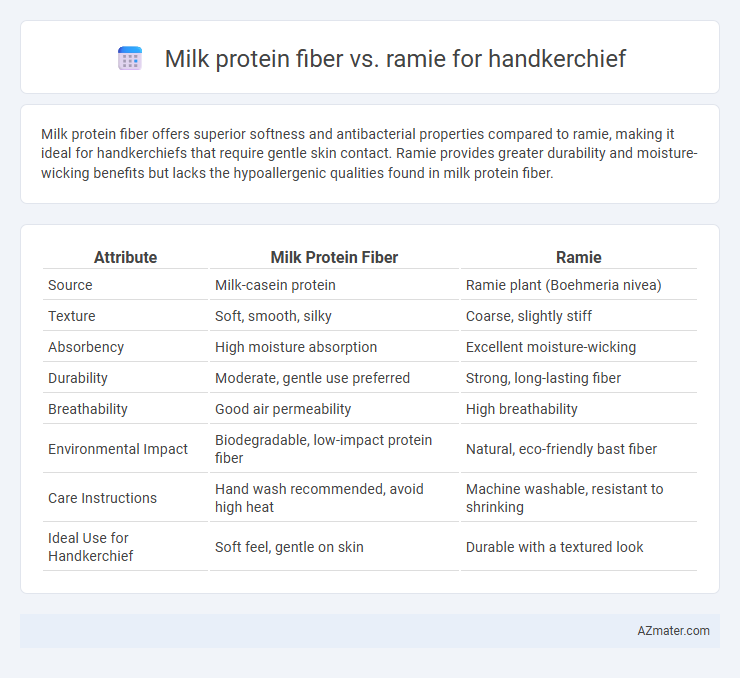Milk protein fiber offers superior softness and antibacterial properties compared to ramie, making it ideal for handkerchiefs that require gentle skin contact. Ramie provides greater durability and moisture-wicking benefits but lacks the hypoallergenic qualities found in milk protein fiber.
Table of Comparison
| Attribute | Milk Protein Fiber | Ramie |
|---|---|---|
| Source | Milk-casein protein | Ramie plant (Boehmeria nivea) |
| Texture | Soft, smooth, silky | Coarse, slightly stiff |
| Absorbency | High moisture absorption | Excellent moisture-wicking |
| Durability | Moderate, gentle use preferred | Strong, long-lasting fiber |
| Breathability | Good air permeability | High breathability |
| Environmental Impact | Biodegradable, low-impact protein fiber | Natural, eco-friendly bast fiber |
| Care Instructions | Hand wash recommended, avoid high heat | Machine washable, resistant to shrinking |
| Ideal Use for Handkerchief | Soft feel, gentle on skin | Durable with a textured look |
Introduction to Milk Protein Fiber and Ramie
Milk protein fiber, derived from casein found in milk, offers exceptional softness, biodegradability, and moisture absorption, making it an innovative choice for handkerchief fabric. Ramie, a natural cellulose fiber extracted from the stalks of the Ramie plant, boasts high tensile strength, excellent luster, and durability, which ensures long-lasting handkerchiefs with a smooth texture. Comparing these fibers highlights milk protein fiber's comfort and eco-friendliness versus Ramie's strength and resilience in handkerchief applications.
Origins and Production Processes
Milk protein fiber originates from casein, a dairy protein extracted from milk through a coagulation process followed by extrusion into fibers, resulting in a sustainable and biodegradable textile option. Ramie, derived from the stalks of the Chinese grass plant Boehmeria nivea, undergoes retting, decortication, and degumming to separate the cellulose fibers, producing a strong, lustrous natural fiber with ancient cultivation history in East Asia. The distinct production methods emphasize milk protein fiber's reliance on dairy by-products versus Ramie's plant-based cellulose extraction, affecting texture, durability, and environmental impact in handkerchief manufacturing.
Fiber Composition and Structure
Milk protein fiber is primarily composed of casein, a protein derived from milk, resulting in a soft, smooth texture with excellent moisture absorption ideal for delicate handkerchiefs. Ramie fiber, extracted from the stalks of the ramie plant, consists mainly of cellulose, providing high tensile strength, durability, and a crisp feel. The protein-based structure of milk fiber contributes to superior softness and hypoallergenic properties, while ramie's cellulose composition ensures longevity and resistance to wear.
Softness and Comfort Comparison
Milk protein fiber offers superior softness and moisture-wicking properties compared to Ramie, making it ideal for handkerchiefs that require gentle touch and comfort. Ramie fabric, while durable and breathable, tends to be coarser, which can reduce overall softness against the skin. Users seeking a plush and smooth handkerchief often prefer milk protein fiber for its natural silk-like texture and enhanced comfort.
Absorbency and Moisture Management
Milk protein fiber offers superior absorbency and moisture management compared to ramie, making it ideal for handkerchiefs that require quick sweat absorption and drying. Ramie, while durable and strong, has less moisture-wicking ability and can retain dampness longer, which may reduce comfort during prolonged use. The milk protein fiber's natural hygroscopic properties enhance breathability and keep the skin feeling dry, providing a more comfortable handkerchief experience.
Durability and Longevity
Milk protein fiber offers superior durability and longevity compared to Ramie when used in handkerchiefs, thanks to its natural protein structure that enhances tensile strength and resistance to wear. Ramie, while also known for its robustness, tends to degrade faster due to its plant-based cellulose composition, which is more susceptible to environmental stress and frequent washing. Choosing milk protein fiber handkerchiefs ensures longer-lasting fabric integrity, maintaining softness and shape over extended use.
Eco-Friendliness and Sustainability
Milk protein fiber excels in eco-friendliness due to its biocompatibility and biodegradability, reducing environmental impact during decomposition. Ramie, a natural bast fiber derived from the stalks of the Chinese nettle plant, demands minimal pesticides and grows quickly, making it a sustainable choice for handkerchief production. Both fibers offer renewable and biodegradable alternatives to synthetic fabrics, with milk protein fiber uniquely providing moisture-wicking and antibacterial properties beneficial for personal use.
Skin Sensitivity and Hypoallergenic Properties
Milk protein fiber offers exceptional hypoallergenic properties and is ideal for sensitive skin due to its natural proteins that nourish and soothe irritation. Ramie, while breathable and durable, may cause slight abrasion or discomfort for highly sensitive skin types. Handkerchiefs made from milk protein fiber are preferred for individuals seeking gentle, skin-friendly fabrics that reduce allergic reactions and promote comfort.
Care and Maintenance Requirements
Milk protein fiber handkerchiefs require gentle care with cold water washing and air drying to maintain softness and prevent damage, while Ramie handkerchiefs are more durable but benefit from hand washing or machine washing in a gentle cycle with mild detergent to avoid fiber weakening. Avoid bleach and high heat drying for both fibers to preserve texture and longevity. Proper storage in a cool, dry place helps reduce wrinkles and fiber degradation for both materials.
Suitability for Handkerchief Use
Milk protein fiber offers exceptional softness and moisture absorption, making it highly suitable for handkerchiefs that require gentle contact with the skin. Ramie, known for its durability and crisp texture, provides excellent strength and quick-drying properties but may feel less soft compared to milk protein fiber. For handkerchief use, milk protein fiber excels in comfort and absorbency, while ramie stands out for longevity and structural integrity.

Infographic: Milk protein fiber vs Ramie for Handkerchief
 azmater.com
azmater.com